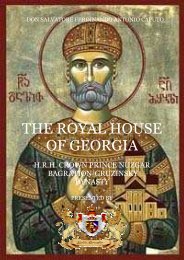here - Nobility Associations
here - Nobility Associations
here - Nobility Associations
You also want an ePaper? Increase the reach of your titles
YUMPU automatically turns print PDFs into web optimized ePapers that Google loves.
The Treaties of Blois (1504–5) gave Naples and Sicily<br />
to Spain, which for two centuries ruled the two<br />
kingdoms through viceroys—one at Palermo, one at<br />
Naples. Gonzalo Fernández de Córdoba was the first<br />
viceroy of Naples. Under Spain, S Italy became one of<br />
the most backward and exploited areas in Europe.<br />
Heavy taxation (from which the nobility and clergy<br />
were exempt) filled the Spanish treasury; agriculture<br />
suffered from the accumulation of huge estates by<br />
quarreling Italian and Spanish nobles and the church;<br />
famines were almost chronic; disease, superstition, and<br />
ignorance flourished. A popular revolt against these<br />
conditions, led by Masaniello, was crushed in 1648. In the War of the Spanish<br />
Succession the kingdom was occupied (1707) by Austria, which kept it by the terms<br />
of the Peace of Utrecht (1713; see Utrecht, Peace of). During the War of the Polish<br />
Succession, however, Don Carlos of Bourbon (later Charles III of Spain) re<br />
conquered Naples and Sicily. The Treaty of Vienna (1738) confirmed the conquest,<br />
and the two kingdoms became subsidiary to the Spanish crown, ruled in personal<br />
union by a cadet branch of the Spanish line of Bourbon. Naples then had its own<br />
dynasty, but conditions improved little.<br />
(Above: GONZALO FERNANDEZ DE CORDOBA,''THE GREAT CAPTAIN” Córdoba, 1453 -<br />
Granada, 1515) was the first viceroy of Naples).<br />
In 1798 Ferdinand IV and his queen, Marie Caroline, fled from the French<br />
Revolutionary army. The Parthenopean Republic was set up (1799), but the<br />
Bourbons returned the same year with the help of the English under Lord Nelson.<br />
Reprisals were severe; Sir John Acton, the queen's favorite, once more was<br />
supreme. In 1806 the French again drove out the royal couple, who fled to Sicily.<br />
Joseph Bonaparte (see under Bonaparte, made king of Naples by Napoleon I, was<br />
replaced in 1808 by Joachim Murat. Murat's beneficent reforms were revoked after<br />
his fall and execution (1815) by Ferdinand, who was restored to the throne (Marie<br />
Caroline had died in 1814). In 1816 Ferdinand merged Sicily and Naples and styled<br />
himself Ferdinand I, king of the Two Sicilies.<br />
Ferdinand I (Ferdinando Antonio Pasquale Giovanni Nepomuceno<br />
Serafino Gennaro Benedetto, January 12, 1751 – January 4, 1825) was King<br />
variously of Naples, Sicily, and the Two Sicilies from 1759 until his death. He<br />
was the third son of King Charles VII of Naples and Sicily by his wife Maria<br />
Amalia of Saxony. On August 10, 1759, Charles succeeded his brother as<br />
King Charles III of Spain. Treaty provisions made Charles unable to hold the<br />
titles of all three Kingdoms. On October 6, 1759 he t<strong>here</strong>fore abdicated in<br />
The Hohenstaufen Dynasty - Page 150 of 200



